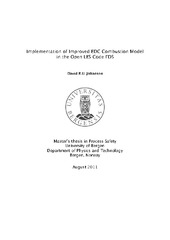| dc.description.abstract | In this thesis, Magnussen’s and Hjertager’s Eddy Dissipation Concept (EDC) Combustion Model has been implemented in the CFD code Fire Dynamics Simulator (FDS). FDS is an open source non-commercial Large Eddy Simulation (LES) code mainly developed by the National Institute of Standards and Technology (NIST). EDC is developed for Reynolds Avarage Navier Stokes (RANS) equations where fluctuating values caused by turbulence are modeled. The reaction rate in EDC is predicted by RANS quantities such as Turbulent Kinetic Energy (TKE) and Dissipation of Turbulent Kinetic Energy, which is not solved explicitly in LES codes. A promising extension of EDC to LES was proposed Panjwani et al. treating eddy viscosity and strain rate instead. In their validation work a model constant was established for jet flames for the Smagorinsky turbulence model. However, the main purpose of FDS is studying smoke spread, fire detection and smoke ventilation in building fires. Such fires involves low Mach number flows driven by buoyancy, in contrast to jet fire that are strongly influenced by the momentum fuel release and are highly turbulent. The first motivation of this thesis has been to implement LES-EDC in FDS, and second to establish a model constant for buoyancy driven fires and evaluate whether a static constant is sufficient or a dynamic constant is necessary. This is solved by validate the code against velocity profiles in Sandia plume experiments, Heskestad flame height correlation, McCaffery centerline temperature and velocity correlation. Results are also compared with the existing combustion model in FDS for the default turbulence model, Deardorff, in the unofficial version 6. Experiments with square pipes inserted in the persistent flame region were performed at Lund University. Particle Image Velocimetry (PIV) technique was applied to measure the velocity vector field above the pipes. The goal was to study the affected of generated turbulence from the pipes and perhaps be able to investigate how the turbulence effected the LES-EDC model constant. Unfortunately, the experiments gave unsatisfactory results for CFD validation. During the experiments it was some technical problems with the shutter on the camera occurred as well as the seeding of particles turned out to be quite challenging. Therefore, this part of the thesis must be regarded as a contribution to the project Prediction and validation of pool fire developed in enclosures by means of CFD models for risk assessment of nuclear power plants which the experiments were linked up to, and not validation of FDS-EDC. Amodel constant of 0.015 gave satisfactory results for all the chosen validation cases. But a somewhat smaller constant is preferable for the centerline temperature and velocity profiles in the McCaffery simulations. With CLES = 0.015 the maximum temperature i over estimated. The slope change in flame height around Q* ≈ 1 was not captured by the Vreman and Deardorff turbulence model. The already existing combustion had the same difficulties. LES-EDC with the Smagorinsky model in addition to the existing combustion did also capture the dip for vertical velocity profile in the Sandia plume experiment test 17. But the disadvantage with the Smagorinsky model is the CPU clock times compared with the two other turbulence models. The errors of the implemented code (referred as FDS-EDC) are in most cases less or the same as for the existing model. The models are also about the same computational expensive. In contrast to the existing model, the implemented code is strongly grid dependent. So before FDS-EDC can be applied in fire analysis the model must be modified to be grid independent. A dynamic constant is not necessary for buoyancydriven fires in fire engineering application but a more accurate constant is recommended to be established. Temperature and velocity should in further work be validated in a wider range of Q* for practical fire sizes than in this thesis. | en_US |
